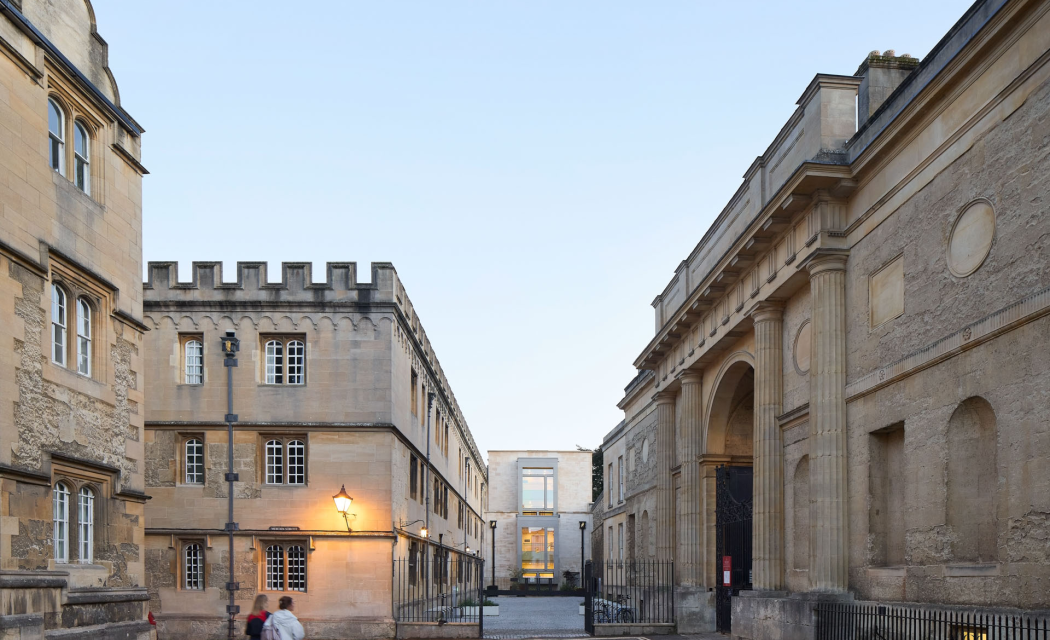- Wright & Wright Architects has completed The Spencer Building, a new Special Collections Centre and Library for Corpus Christi College, Oxford.
- The building consolidates the College’s exceptional collection of manuscripts and early printed books into a single, purpose-built home.
- For the first time in the College’s 508-year history, step-free access has been created to the historic Old Library – opening up this remarkable space to all.
- Certified to full Passivhaus standards, it ranks among the first libraries at Oxford – and a rare few nationwide – an especially notable feat in a heritage context.
Wright & Wright Architects has completed The Spencer Building for Corpus Christi College, Oxford – a contextually sensitive but ambitious addition that provides state-of-the-art archival and study spaces for one of the finest college collections in the world.
The project marks a milestone in the College’s 508-year history, addressing urgent needs for accessibility, sustainability, and safeguarding of collections. For the first time, the historic Old Library is step-free, welcoming all members of the community. The 479 m² building also introduces 55 new reader spaces, six dedicated research desks, and just under 2,000m of archival shelving.
A new home for special collections:
Corpus Christi’s special collections are of international significance, containing more than 20,000 early printed books and 546 manuscripts, including works by Galileo, Erasmus and the Venerable Bede. The Spencer Building consolidates these holdings in an environmentally controlled core, with dedicated research desks for close study.
New into old:
The site of the Spencer Building has itself undergone many transformations. Originally built as the President’s Lodgings in the 17th century, it is the most altered part of the College, shaped over centuries by successive Presidents. With only the eastern wing of the original structure remaining, the site was uniquely suited to accommodate the Special Collections Library.
The new building rises modestly within a highly constrained site, framed by three historic features: the medieval City Wall to the west, a listed facade facing the Garden Quad to the east, and the College’s Old Library to the south. Historic fabric is retained on three elevations, while a refined new limestone facade on Oriel Square replaces a 1950s garage, restoring a dignified civic presence. A large ‘library window’ punctuates the facade, borrowing from the College’s distinctive windows that traditionally mark key social spaces such as the Hall and Chapel. By night, low-level lighting casts a warm glow across the new forecourt, turning the building into a discreet beacon for students returning to College.
This dialogue between old and new is accentuated by the Spencer Building’s new staircase, aligned on axis with the Old Library. From the new library, you can look both inward towards the Old Library’s end wall and the Chapel’s beautiful stained-glass window, as well as out of the large window across Oriel Square to the Radcliffe Camera.
Achieving Passivhaus certification:
Designing to rigorous Passivhaus standards in a historic site posed challenges, particularly in achieving high levels of insulation and airtightness within retained historic fabric. In collaboration with Passivhaus consultants Max Fordham, the archive was placed in a new insulated, airtight concrete bunker built against the City Wall, harnessing its thermal mass to create stable, low-energy environmental conditions for the collections. This freed the building’s east side for naturally lit reader spaces, where triple-glazed windows minimise energy consumption and ensure comfort.
The roof is fitted with photovoltaic panels while a highly efficient mechanical ventilation system with heat recovery maintains air quality with minimal energy input. Space heating is delivered by a ground-source heat pump, as part of an all-electric building strategy. Together, these measures reduce the building’s expected heating demand to just 15 kWh/m²/year, aligning both predicted heating and total operational energy use with the pilot version of the Net Zero Carbon Building Standard.
A place of focus and exchange:
Three distinct reading rooms offer varied atmospheres – from monastic individual carrels to collaborative study tables – each filled with daylight and views over the Garden Quad. Bespoke oak and brass furniture, combined with careful detailing, enrich the student experience. Despite the dominance of digital media, the Spencer Building reaffirms the enduring importance of physical spaces for study, exchange and contemplation.
Accessible for all:
Thoughtfully planned to meet diverse needs, the new Spencer Building is fully accessible, with space provision for wheelchair users, power-assisted doors, and accessible toilets throughout. Most significantly, for the first time in the College’s 508-year history, step-free access has been created to the historic Old Library, opening up this remarkable space to all.
This new step-free route includes three key features: level access at the Spencer Building entrance; a lift beside the main staircase providing access to all floors; and a wheelchair-accessible study space within the Old Library itself, equipped with a rise-and-fall desk.
Clare Wright, Founding Partner at Wright & Wright Architects, said: "Existing elements and conditions were a starting point, not a constraint. The Spencer Building emerges from Corpus’s historic fabric, generating unexpected synergies and introducing sustainable, inclusive and forward-looking spaces."
Professor Helen Moore, President at Corpus Christi College Oxford, said: "At Corpus, we are always mindful of our responsibilities as custodians of our College’s history and also its future. In that light, we are delighted at the news that the Spencer Building has secured full Passivhaus accreditation. This achievement truly embodies our vision of encompassing simultaneously the best of the old and the best of the new."
